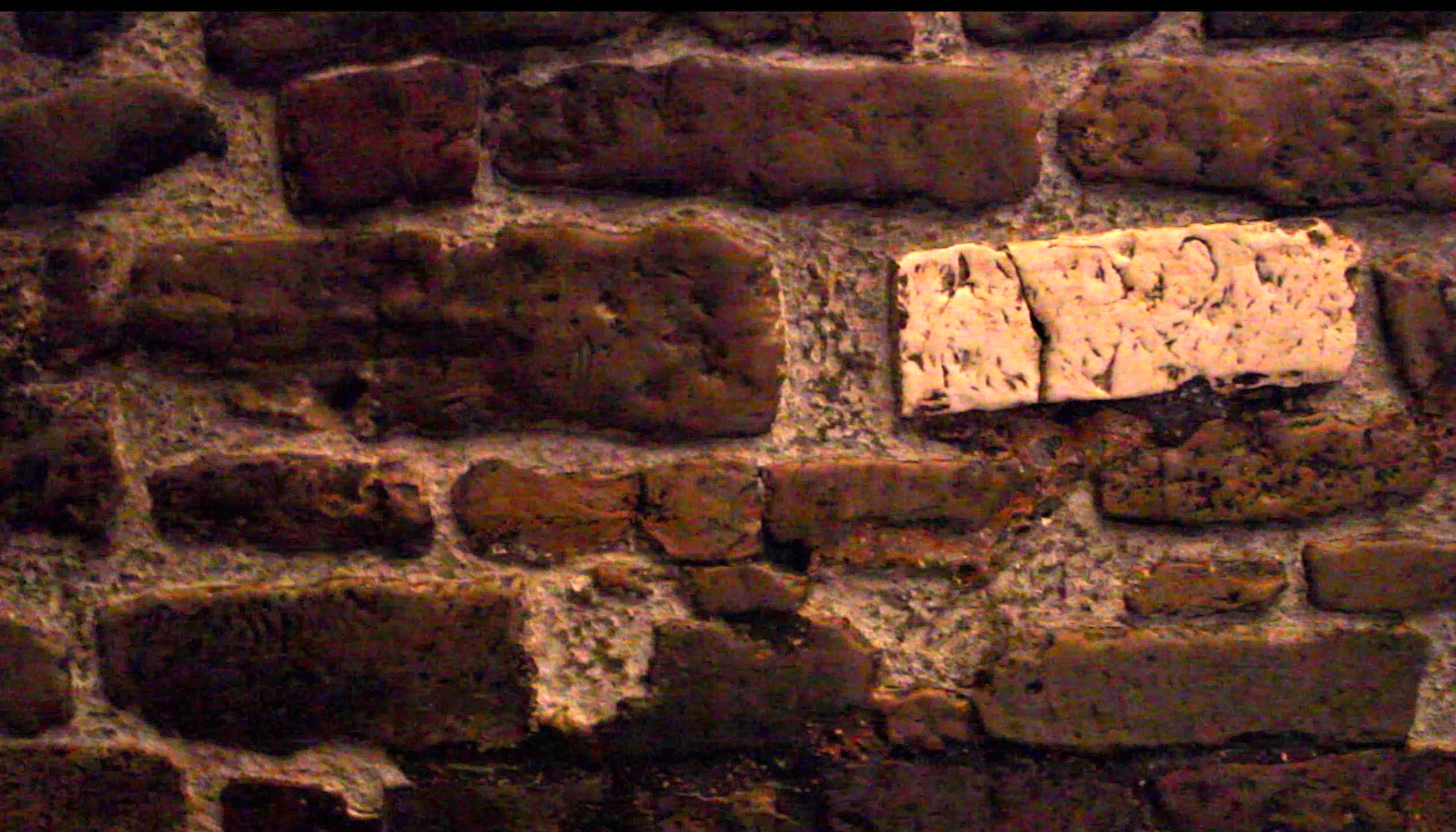Home
Works:
older
LET'S VISIT THE HOUSE! (2017)
(projection, photographs, wax sculpture) - video 8'35"
The installation 'Let's visit the house' tries to unravel the complex concept of relic through which religious
institutions strengthen its power on the believers.
My work refers to the legend of the holy house in Loreto (Italy) and questions the sacred value of the place itself. With my research I address the history of the Virgin Mary’s cave in Nazareth (Israel) in relation to Loreto (Italy), a town near the place where I was born on the Adriatic coast. In this small town three walls are conserved that are part of the Virgin Mary’s house in Nazareth. According to the legend, the house in Nazareth was made up of three stone walls enclosing a cave. The cave is still worshipped in Nazareth, while the three walls, were transported in 1294 supposedly by angels from Nazareth to Loreto. Current historical studies reveal that the walls were probably transported to Loreto by sea by the Angeli family (‘angels’ in Italian) who were crusaders. The purpose of the crusaders, relatives of the emperors of Constantinople, was to protect and preserve the walls from the Muslim conquest of the Holy Land, after the expulsion of the Christians from Palestine. Since the Virgin Mary’s walls were removed from its original place in Nazareth to be transported to Italy, is the holiness of the relic defined by the relic itself or by its original place? Does the removal of a relic, affect the value of the relic or the place?
This installation is the result of a larger research about the political value of religious places. My research investigates the processes through which people revitalize religions as a basis for a collective identity and how the relic or a a sacred space legitimizes territorial (and thus political) claims.
My work refers to the legend of the holy house in Loreto (Italy) and questions the sacred value of the place itself. With my research I address the history of the Virgin Mary’s cave in Nazareth (Israel) in relation to Loreto (Italy), a town near the place where I was born on the Adriatic coast. In this small town three walls are conserved that are part of the Virgin Mary’s house in Nazareth. According to the legend, the house in Nazareth was made up of three stone walls enclosing a cave. The cave is still worshipped in Nazareth, while the three walls, were transported in 1294 supposedly by angels from Nazareth to Loreto. Current historical studies reveal that the walls were probably transported to Loreto by sea by the Angeli family (‘angels’ in Italian) who were crusaders. The purpose of the crusaders, relatives of the emperors of Constantinople, was to protect and preserve the walls from the Muslim conquest of the Holy Land, after the expulsion of the Christians from Palestine. Since the Virgin Mary’s walls were removed from its original place in Nazareth to be transported to Italy, is the holiness of the relic defined by the relic itself or by its original place? Does the removal of a relic, affect the value of the relic or the place?
This installation is the result of a larger research about the political value of religious places. My research investigates the processes through which people revitalize religions as a basis for a collective identity and how the relic or a a sacred space legitimizes territorial (and thus political) claims.


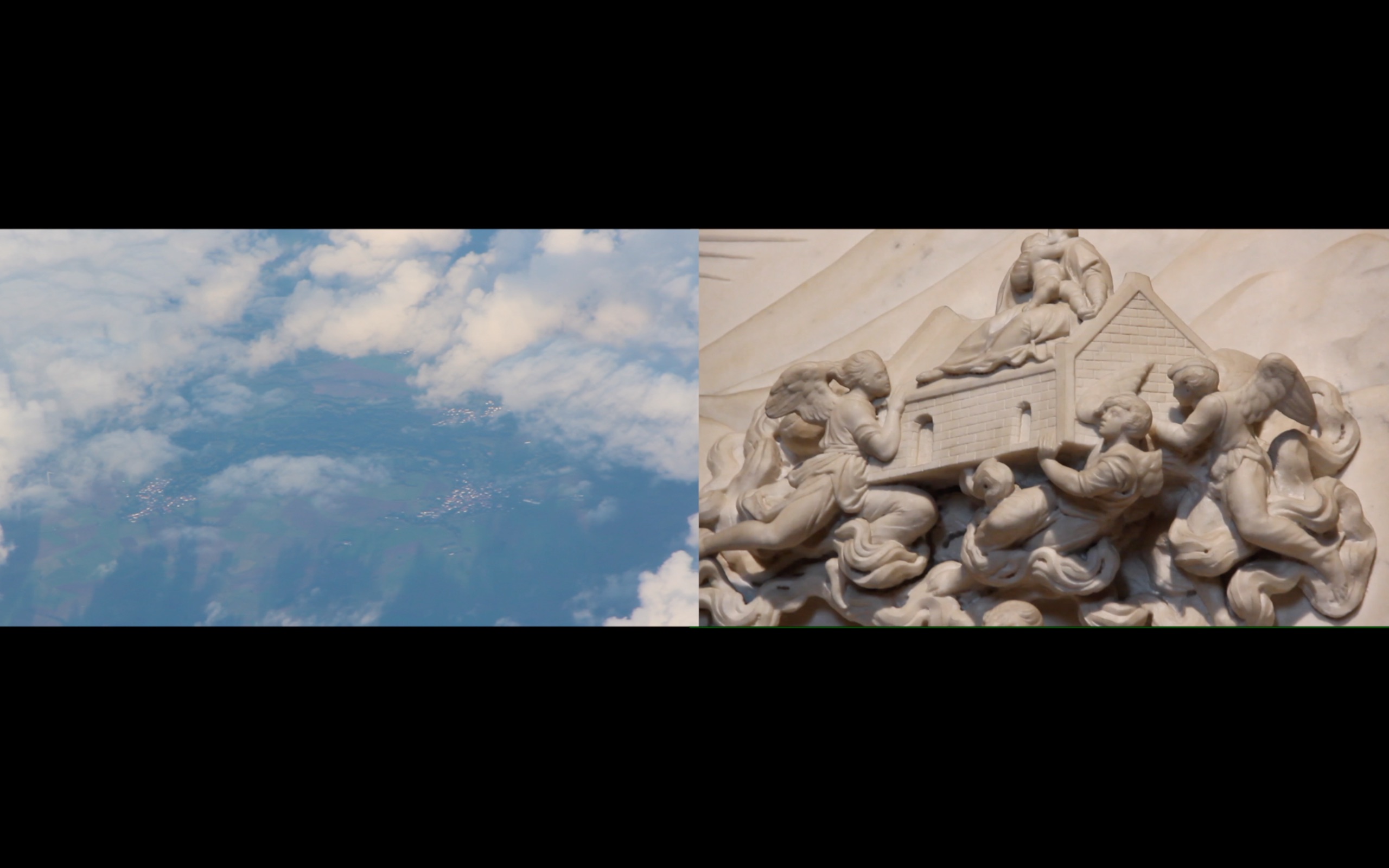


Let's visit the house - video stills



Exhibition view at Wilhelmina pakhuis, Amsterdam
___________________________________________________________________________________________________________


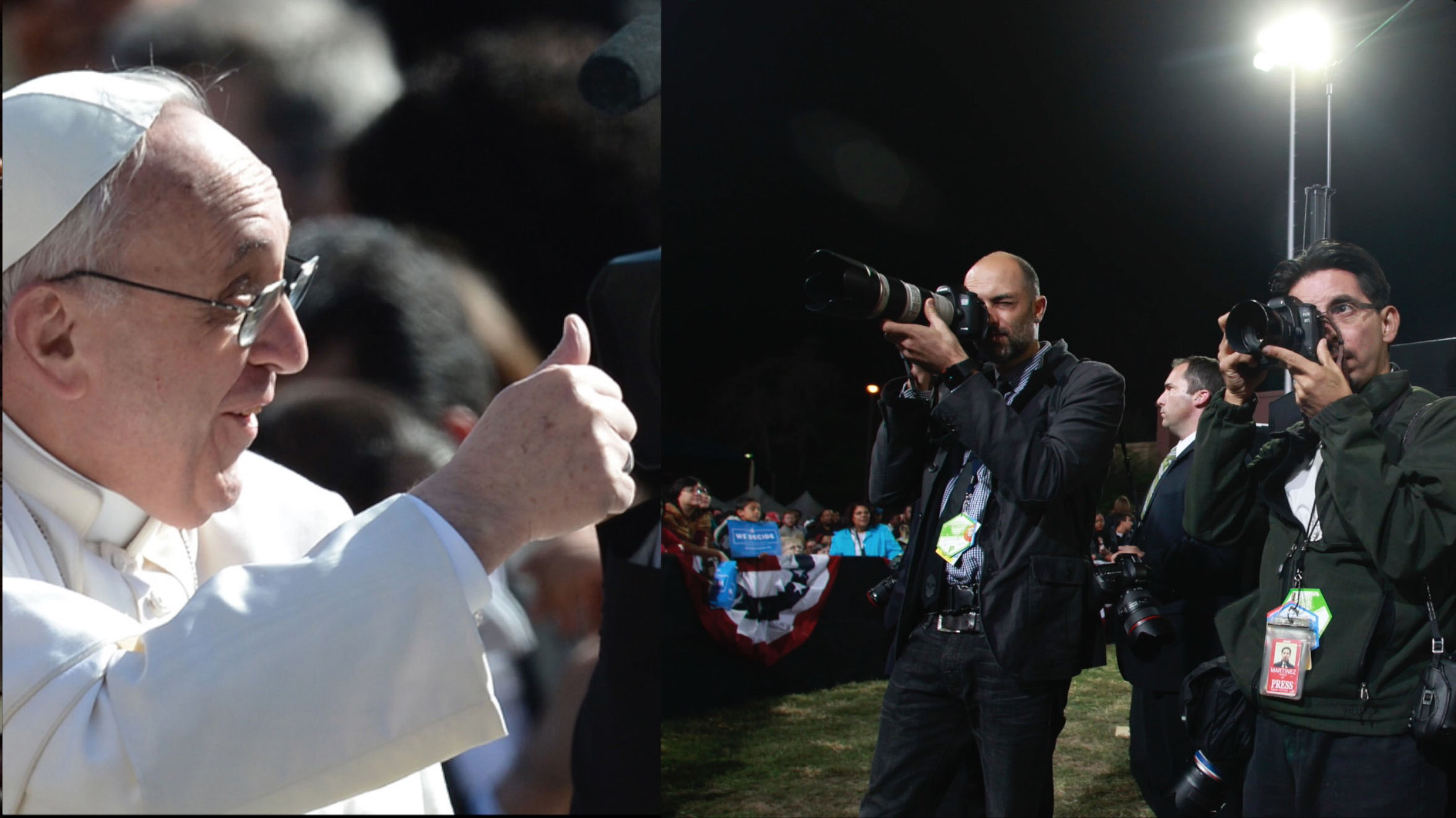


(click on the image to watch a video excerpt)
A GLORIOUS SOCIETY (2015)
new and found footages
Contemporary media images, produced by political or religious
institutions, are constructed to affirm their power. But what happens
when images contradict sound or voice? What difference does it make for
the effectiveness of the political message that the person speaking the
words is not the person mouthing the words on screen? Dismembering a
speech from the applause, a voice from the speaker, a leader from his
audience, I create awareness about the manipulative status of the
original image. Manipulating footages posted on YouTube, I enact a
strategy to disturb the viewer’s perception of the images and to
interrupt the consensus that generally is given to it.
If power is essentially the ability to govern, why has to take the form of ceremonies, protocols, mediatization? As the Italian philosopher Giorgio Agamben states, acclamation is a powerful tool that survive in modern society in the form of public opinion and mediatization from early christianity and roman empire. If the media are so important in modern democracy, this is not simply because they allow to control and govern the public opinion, but also because in this way they distribute glory and therefore power. My project investigate the strategy with which power structures, as politics and church, use their own image in the public media.
Public screening:If power is essentially the ability to govern, why has to take the form of ceremonies, protocols, mediatization? As the Italian philosopher Giorgio Agamben states, acclamation is a powerful tool that survive in modern society in the form of public opinion and mediatization from early christianity and roman empire. If the media are so important in modern democracy, this is not simply because they allow to control and govern the public opinion, but also because in this way they distribute glory and therefore power. My project investigate the strategy with which power structures, as politics and church, use their own image in the public media.
THE GREAT ESCAPE (2015)
Graduation Show Master Artistic Research - Royal Academy of Art (KABK), The Hague.
Exhibition curated by Maziar Afrassiabi & Jack Segbars
exhibition view (foto: Katarína Gališinová)
THE FINE ART OF PEACEMAKING (2015)
The Hague Peace Projects in collaboration with exhibition space GEMAK, The Hague
(click here to read a report of the event)
FRAME OF MIND (2015)
De KIJKDOOS Project Space, Amsterdam
(De Kijkdoos)
OVER GRENZEN, DE MENSELIJKE MAAT (Across borders, the human dimension) 2016
# Aftrap4 - ARTtrium
Ministerie van Binnenlandse Zaken en Koninkrijksrelatie (Ministry of Interior), The Hague
(Exhibition catalog)

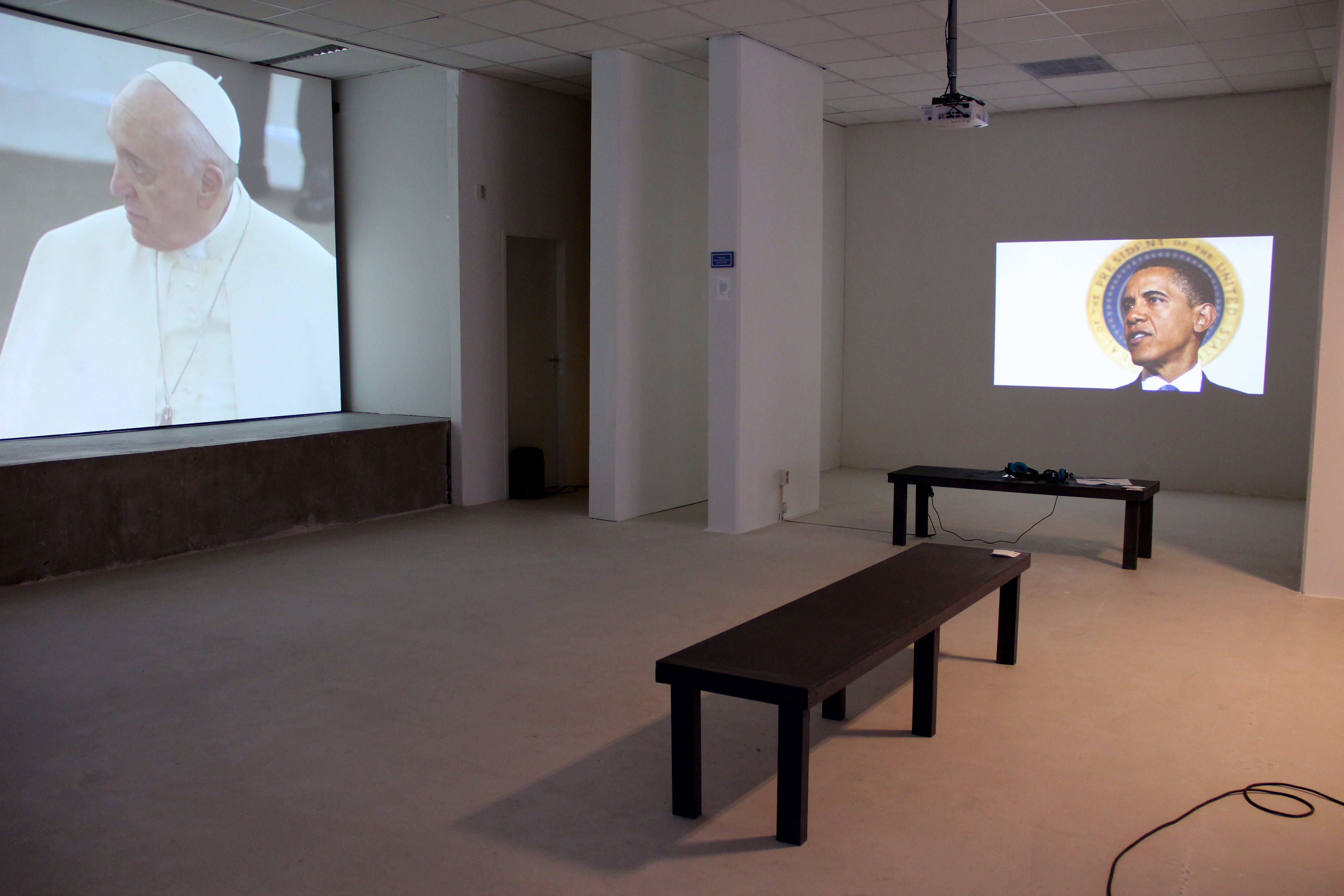
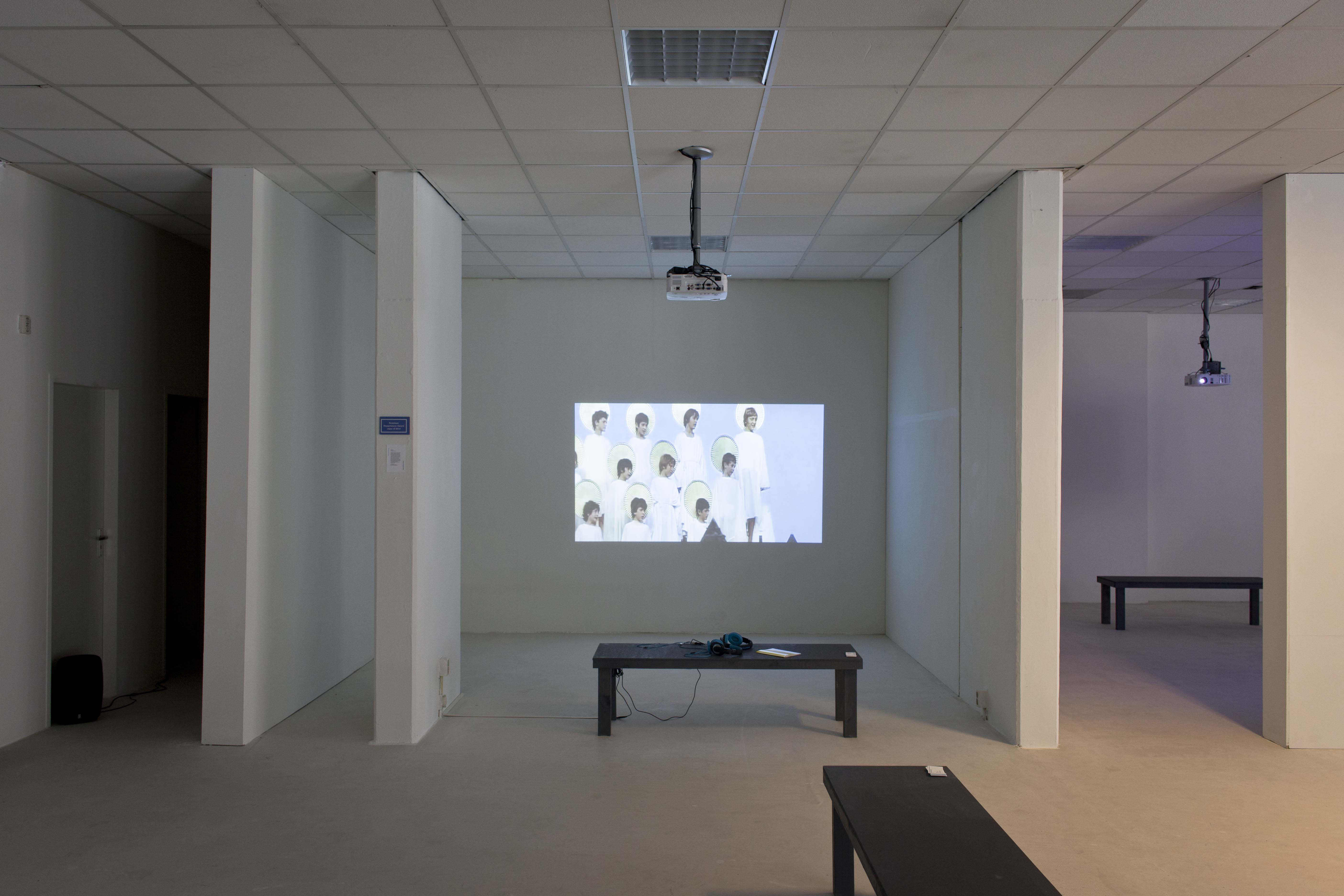
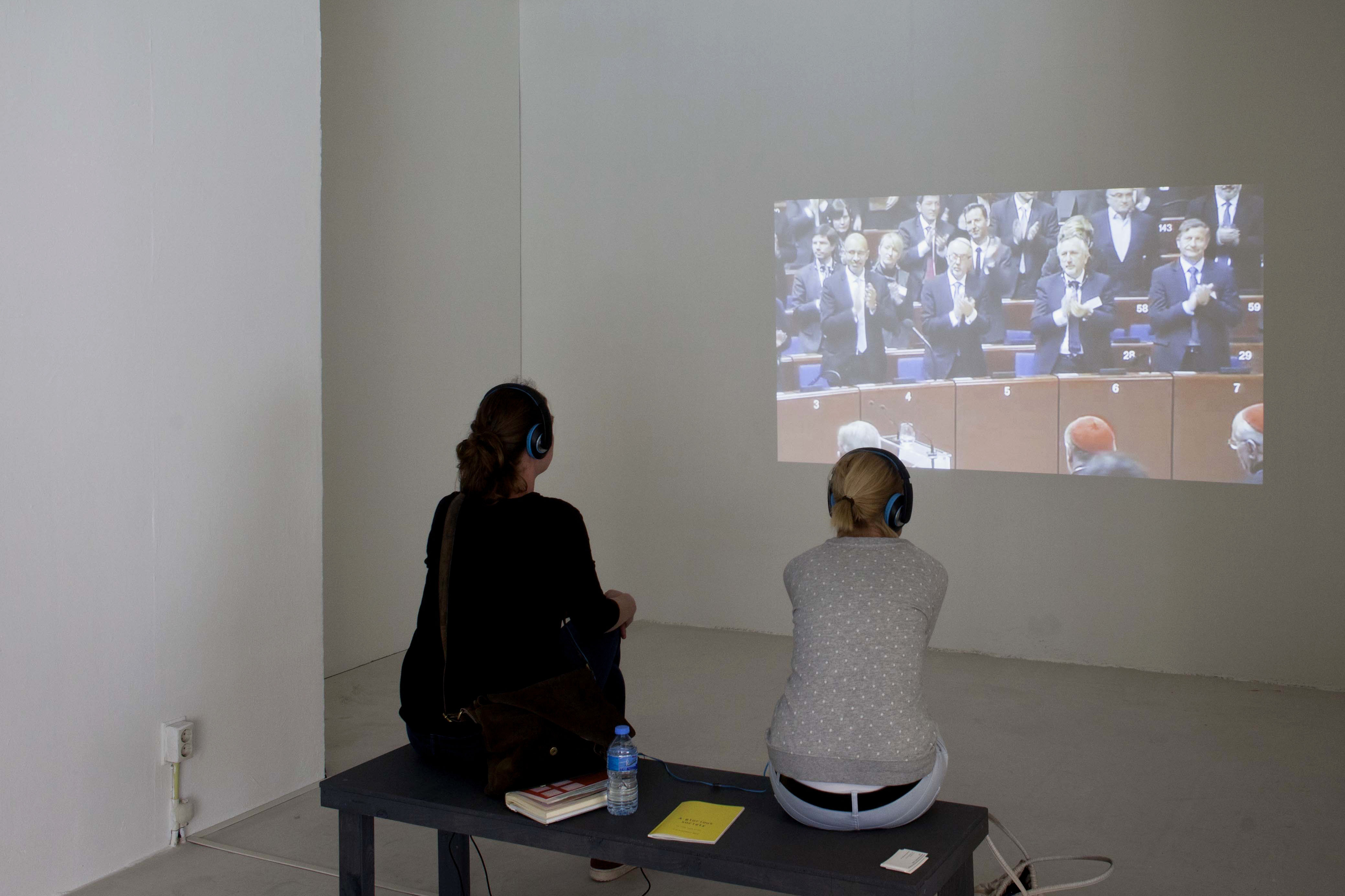
________________________________________________________________________________________________________________


(click on the image to watch the video: password MAR2015)
CONSENSUS (2015)
video, color, sound, 12'26",
(video stills) new and found footages (Youtube / http://www.ctv.va)
How
are words transformed into power and how do they gain authority? What
happens when images contradict sound or voice? What difference does it
make to the political message that the person speaking the words is not
the person mouthing the words on screen? The video's of the project IN
PRINCIPIO ERAT VERBUM explore the performativity of the political and
religious speech through the disembodiment of the voice and question
the value of the spoken word in relation to its performer.
In my latest work, I have been dealing with the Pope's speech given to the European parliament on the 25th of november 2014. The religious leader was invited by Martin Schulz, the president of the european Parliament, during his previous visit to the Vatican on 11 October 2013. If there is a separation between church and state, why did the european parliament invite the Pope? Could it be that, through the invitation, the parliament admits indirectly that it has lost its power to think and implement solutions that could bring a real change in the present crisis? Europe is going through an economic crisis as well an identity crisis. The European Union is also confronted with the upcoming radicalization of Islam and terrorist violence. Therefore Europe by going back to it's Christian roots and, through the authority of the religious leader, tries to bring back unity, identity and especially power, in terms of authority. To reclaim its power, politics brings the ‘sacred’ into its environment, like the ancient kings needed the divine investiture to legitimize their role.
The whole speech is a 35 min. speech. I reduced the footage to 13 min.following the strategy of consensus. That means that I selected all the sentences / part of the speech at which the audience applauded. With the shorter speech, I want to question the power given to the speech, related to the function of who is declaiming it, regardless of the content of the speech.
Public screening: In my latest work, I have been dealing with the Pope's speech given to the European parliament on the 25th of november 2014. The religious leader was invited by Martin Schulz, the president of the european Parliament, during his previous visit to the Vatican on 11 October 2013. If there is a separation between church and state, why did the european parliament invite the Pope? Could it be that, through the invitation, the parliament admits indirectly that it has lost its power to think and implement solutions that could bring a real change in the present crisis? Europe is going through an economic crisis as well an identity crisis. The European Union is also confronted with the upcoming radicalization of Islam and terrorist violence. Therefore Europe by going back to it's Christian roots and, through the authority of the religious leader, tries to bring back unity, identity and especially power, in terms of authority. To reclaim its power, politics brings the ‘sacred’ into its environment, like the ancient kings needed the divine investiture to legitimize their role.
The whole speech is a 35 min. speech. I reduced the footage to 13 min.following the strategy of consensus. That means that I selected all the sentences / part of the speech at which the audience applauded. With the shorter speech, I want to question the power given to the speech, related to the function of who is declaiming it, regardless of the content of the speech.
IN PRINCIPIO ERAT VERBUM (2015)
Gallery 1646, The Hague (February 2015)
(1646.nl)
THE GREAT ESCAPE, Graduation Show Master Artistic Research - Royal Academy of Art (KABK), The Hague.
Exhibition curated by Maziar Afrassiabi & Jack Segbars (July 2015)
FRAME OF MIND (2015)
DE KIJKDOOS Project Space, Amsterdam
(De Kijkdoos)
OVER GRENZEN, DE MENSELIJKE MAAT (Across borders, the human dimension) 2016
# Aftrap4 - ARTtrium
Ministerie van Binnenlandse Zaken en Koninkrijksrelatie (Ministry of Interior), The Hague
(Exhibition catalog)
_____________________________________________________________________________________________________________
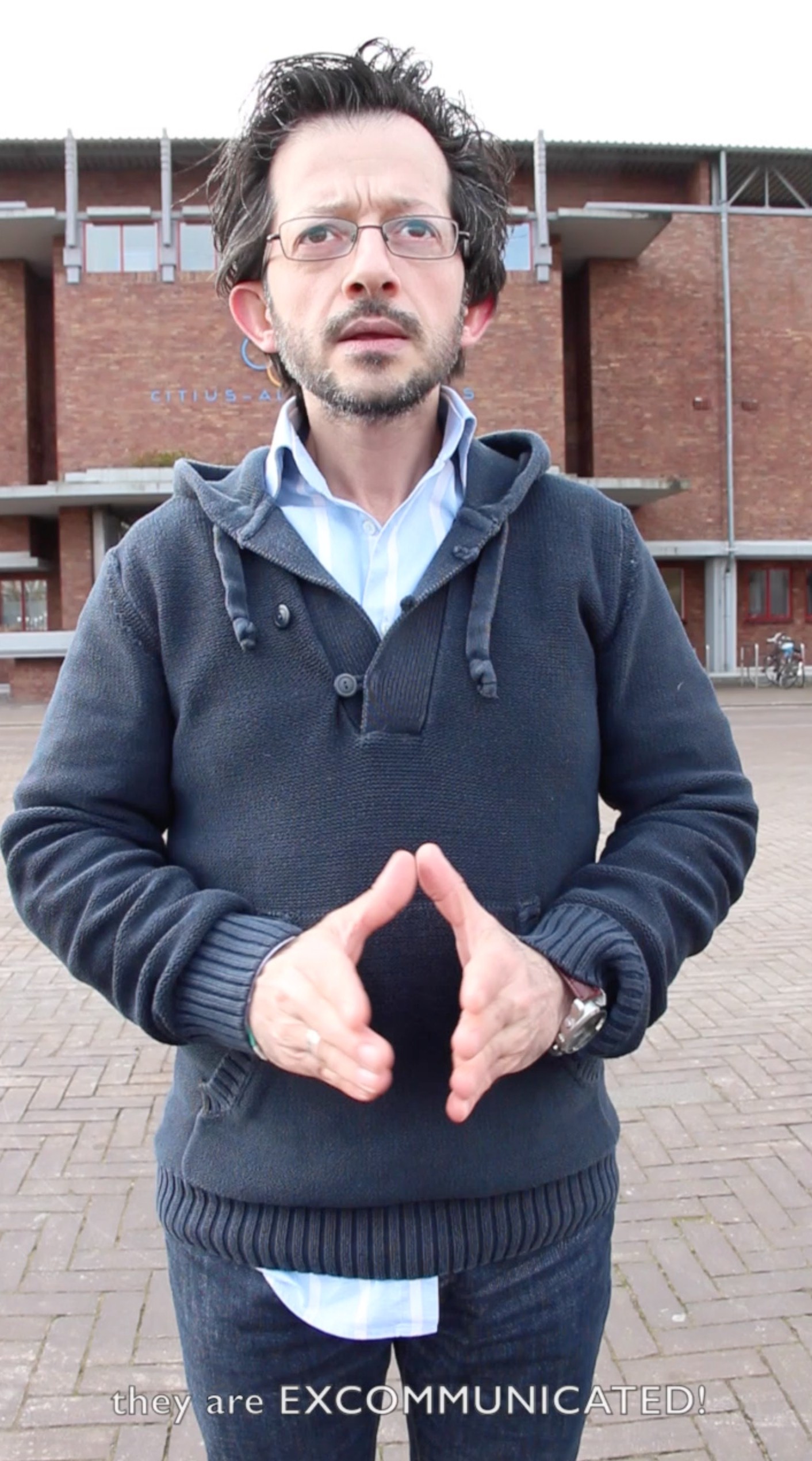

EXCOMMUNICATION (2015)
video, color, sound, 11'00",
(video stills), sound (http://www.ctv.va)
On
June 22, 2014 Pope Franciscus, visiting the region of Calabria in the
South of Italy, expressed for the first time an official
excommunication against the ‘Ndrangheta, a Mafia-type criminal
organization, centered in Calabria. I was interested in the power of
the word as a performative act. The excommunication by the Pope of the
criminal organization (which means excluded from the religious
community), is not enforced by the police but lay on the value of the
words resonating in the conscience of every single person. To question
the value of the spoken word and in relation to its performer, I
divided the voice from the body, the words from the Pope. I performed
the speech lip synching the voice of the Pope in different settings and
backgrounds. One, is recorded in front of the old olympic stadium of
Amsterdam
Public screening:
IN PRINCIPIO ERAT VERBUM (2015)
Gallery 1646, The Hague (February 2015)
___________________________________________________________________________________________________________
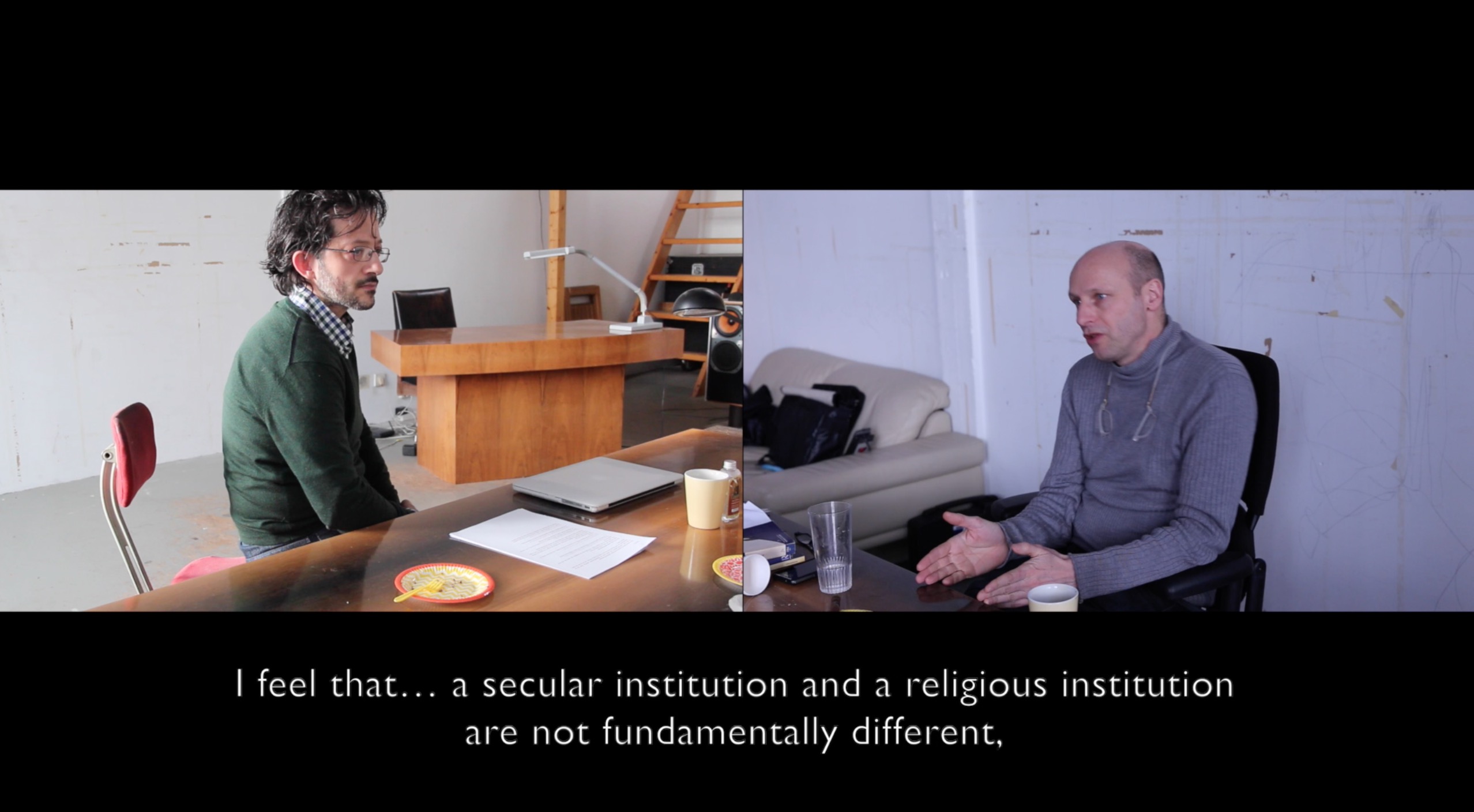
IN CONVERSATION WITH AERNOUT MIK (2015)
video, color, sound, 14'17", (video stills)
1646 The Hague (February 2015)
(publication of the Conversation - 1646 Gallery)
The
conversation between me and Aernout Mik was part of the the exhibition
at 1646 in The Hague. Aernout and
I discussed the work process but also the general topics addressed by
my video, such as the value of the political and religious
institutions, and the manifestation of their hierarchical power through
media and appearance. To challenge even more the hierarchical value of
voice within our meetings, I proposed to Aernout to record our
conversation and later to lip synch each others voice. The content of
the conversation belongs to the real speaker but the voices are
switched. Can this manipulation disturbed the viewer’s perception of
the value given to the content of the conversation?
Public screening:
IN PRINCIPIO ERAT VERBUM (2015)
Gallery 1646, The Hague (February 2015)




(foto: Floris Kruidenberg)
IN PRINCIPIO ERAT VERBUM (2015), exhibition view at 1646 (http://1646.nl/projects/the-ongoing-conversation-22)

(click on the image to watch the video: password MAR2015)
MARE NOSTRUM (2014)
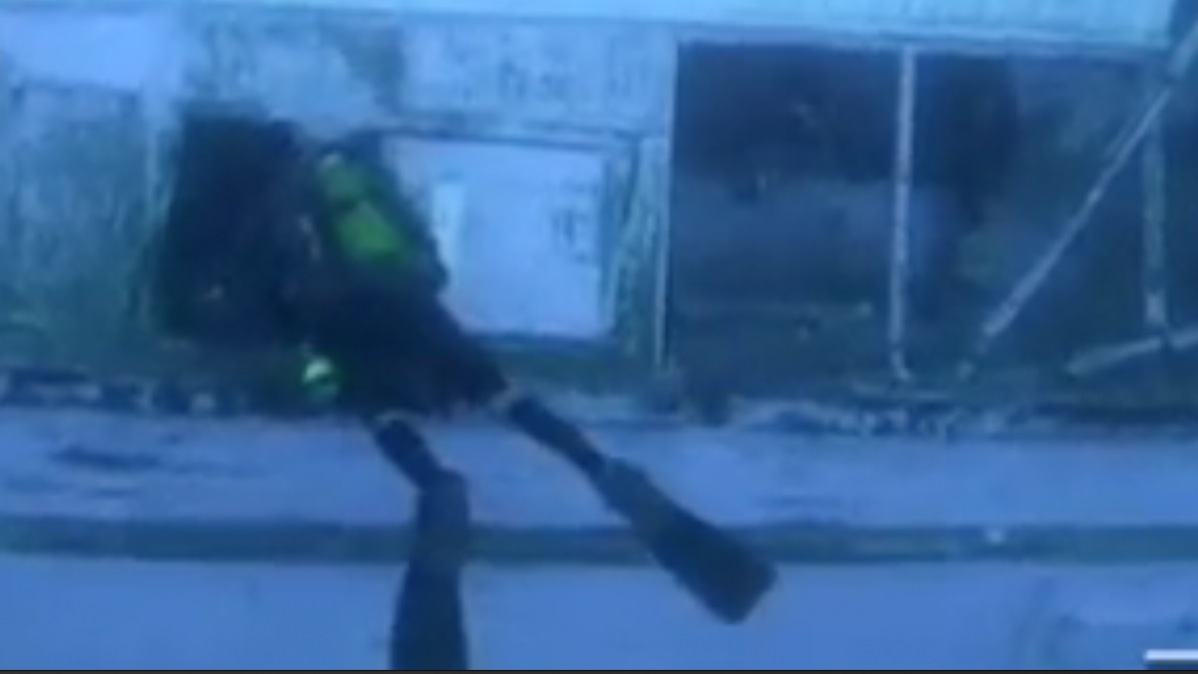


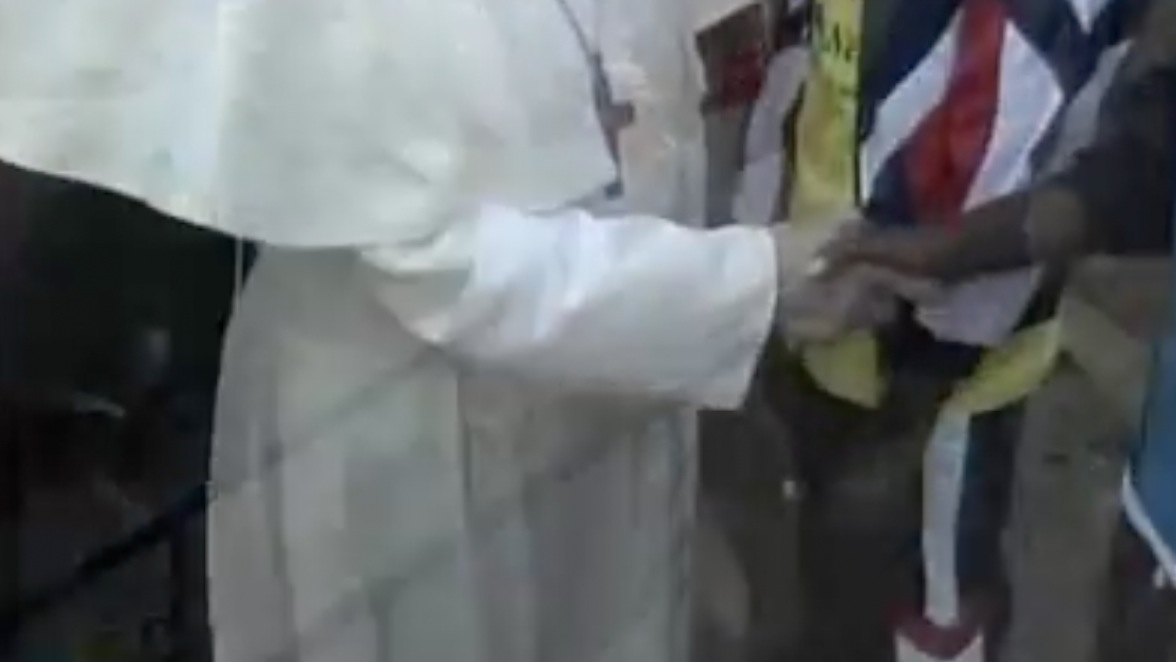
MARE NOSTRUM (2014)
video, color, sound, 6'41"
(video stills) / footage Youtube
My work Mare Nostrum was developed during a collaborative research with the refugees collective We Are Here (part of the Learning Programme host by BAK). Composed of footage found on YouTube, the work deals with
several aspects and consequences of migration from Africa to Italy for both the
refugees and the hosting country: the dangers of the sea, rescue efforts by Italian
institutions, the gestural responses of a religious leader, and reactions of
ordinary people to what is often called an “invasion” from Africa.
The images, originally published by YouTube subscribers, demonstrate how the
phenomenon of migration has captured people’s imaginations from humanistic, religious, and
political points of view. The work also draws attention to the context of the
footage’s initial
publication and circulation, largely driven by the media, which decide what to
and what not to show in an effort to sway public opinion.
Public screenings:
BAK Basis voor actuele kunst, Utrecht (2014)
Circular Permutation-in between negative space, W 139 Amsterdam (January 2015)

MAPPING THE LADY IV (2014)
Quartair Contemporary art initiatives - The Hague
The "popular religiosity" is the
expression of the religious sentiment of people. The Church, through
the centuries, established in modern devotion, a separation between
personal and institutional religious attitudes. This separation as a
warning against dangerous elements in the popular expressions for the
power concealed by the canonical dogmas. My artistic practice explores
the field of tension and mutual dependence between these two opposites,
as a metaphor of modern power strategies.
Exhibition:
QUARTAIR Contemporary art initiatives - The Hague (2014)
MARCHE CENTRO D'ARTE (MCDA) - San Benedetto del Tronto, Italy (2015)
HIGHER BY SPINNING - Sarajevo, Bosnia - Herzegovina (2017)

MAPPING THE LADY IV (2014)
(installation view)

MAPPING THE LADY IV (2014)
(installation view)



CENTENO VS CHURCH 2014
video, color, no sound, 2'31"
(video stills) / footage Youtube
A recent confrontation between the "popular expression of religiosity" and the institutional dogmas of the church
is the event of Centeno (Argentina) where a woman, in 2010, claimed to
have seen the Virgin Mary who indicated her a source of healing water.
The Virgin also performed and still do, many healings through the
seer’s laying on of hands. The laying on of hands is a ritualact in which a priest
or other religious functionary places one or both hands palms down on
the top of another person’s head, usually while saying a prayer or
blessing.The church use this ritual act, primarily in the rites of the
dedication and commissioning of ministers.One year later the archbishop
of Santa de la Vera Cruz (Argentina) declared the untruthfulness of the
Marian apparitions in Centeno, because of the disapproval of the
woman’s practice of blessing the faithful.
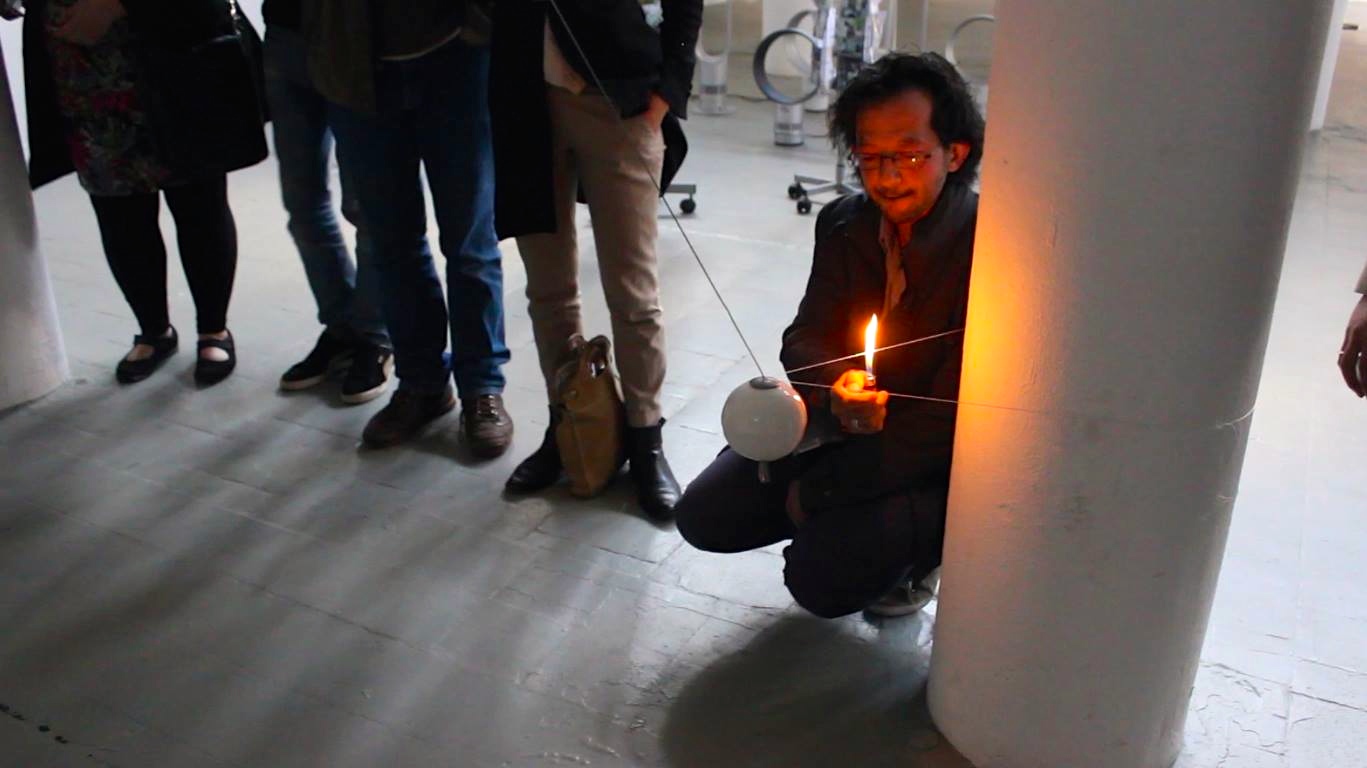
MAPPING THE LADY IV (2014)
(launch of the pendulum, burning the thread which hold the bob in its starting position)
The pendulum of Foucault (1851) as a symbol of the scientific world, used to smash down by chance the Maria's of clay. The installation is a comment on the
institutional power of the church hidden behind the rules to proceed in
the discernement of presumed apparitions or revelations.
MAPPING THE LADY IV (2014)
(installation view)
MAPPING THE LADY IV (2014)
(installation detail)
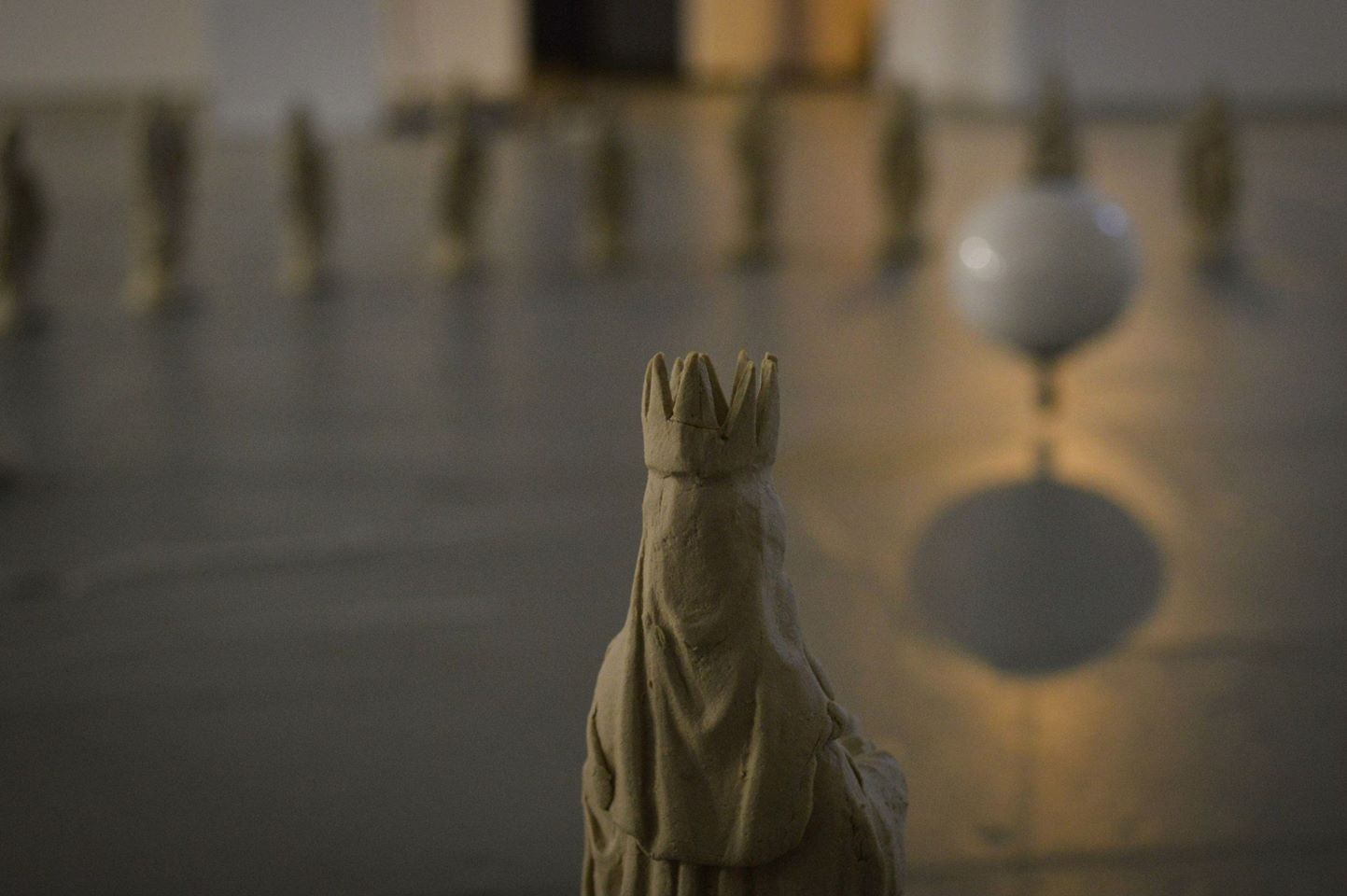

MAPPING THE LADY IV (2014)
(installation detail)
